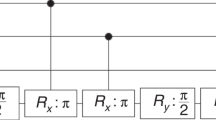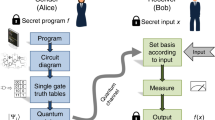Abstract
Only a few classes of quantum algorithms are known which provide a speed-up over classical algorithms. However, these and any new quantum algorithms provide important motivation for the development of quantum computers. In this article new quantum algorithms are given which are based on quantum state tomography. These include an algorithm for the calculation of several quantum mechanical expectation values and an algorithm for the determination of polynomial factors. These quantum algorithms are important in their own right. However, it is remarkable that these quantum algorithms are immune to a large class of errors. We describe these algorithms and provide conditions for immunity.
Similar content being viewed by others
References
Shor P.W.: Why haven’t more quantum algorithms been found. J. ACM 50, 87–90 (2003)
Shor P.: Progress in quantum algorithms. Quantum Inf. Process. 3, 5–13 (2004)
Shor P.W.: Polynomial-time algorithms for prime factorization and discrete logarithms on a quantum computer. SIAM J. Comp. 26, 1484–1509 (1997)
Grover, L.K.: A fast quantum mechanical algorithm for database search. In: Proceedings of the 28th Annual ACM Symposium on the Theory of Computing, pp. 212–219. ACM, New York, NY (1996)
Feynman R.P.: Simulating physics with computers. Int. J. Theor. Phys. 21, 467–488 (1982)
Lloyd S.: Universal quantum simulators. Science 273, 1073–1078 (1996)
Meyer D.A.: Quantum mechanics of lattice gas automata: one-particle plane waves and potentials. Phys. Rev. E 55, 5261–5269 (1997)
Boghosian B.M., Taylor W.: Quantum lattice-gas models for the many-body Schrodinger equation in d dimensions. Phys. Rev. E 57, 54–66 (1998)
Zalka C.: Simulating quantum systems on a quantum computer. Proc. R. Soc. Lond. Ser. A 454, 313–322 (1998)
Abrams D.S., Lloyd S.: Simulation of many-body fermi systems on a universal quantum computer. Phys. Rev. Lett. 79, 2586–2589 (1997)
Terhal B.M.: Bell inequalities and the separability criterion. Phys. Lett. A 271, 319–326 (2000)
Freedman M.H., Kitaev A., Wang Z.: Simulation of topological field theoriesby quantum computers. Commun. Math. Phys. 227, 587–603 (2002)
Lidar D.A., Wang H.: Calculating the thermal rate constant with exponential speed- up on a quantum computer. Phys. Rev. E 59, 2429–2438 (1999)
Ortiz G., Gubernatis J.E., Knill E., Laflamme R.: Quantum algorithms for fermionic simulations. Phys. Rev. A 64, 022319-1–022319-14 (2001)
Wu L.-A., Byrd M.S., Lidar D.A.: Polynomial-time simulation of the BCS Hamiltonian. Phys. Rev. Lett. 89, 057904-1–057904-4 (2002)
Jane E., Vidal G., Dür W., Zoller P., Cirac J.I.: Simulation of quantum dynamics with quantum optical systems. Quantum Inf. Comp. 3, 015–037 (2003)
Shor P.W.: Scheme for reducing decoherence in quantum memory. Phys. Rev. A 52, R2493–R2496 (1995)
Steane A.: Quantum computing. Rep. Prog. Phys. 61, 117 (1998)
Calderbank A.R., Shor P.W.: Good quantum error correcting codes exist. Phys. Rev. A 54, 1098–1105 (1996)
Gottesman, D.: Stabilizer Codes and Quantum Error Correction. Ph.D. thesis, California Institute of Technology, Pasadena, CA (1997). Eprint quant-ph/9705052
Zanardi P., Rasetti M.: Noiseless quantum codes. Phys. Rev. Lett. 79, 3306–3309 (1997)
Duan L.-M., Guo G.-C.: Reducing decoherence in quantum-computer memory with all quantum bits coupling to the same environment. Phys. Rev. A 57, 737–741 (1998)
Lidar D.A., Chuang I.L., Whaley K.B.: Decoherence free subspaces for quantum computation. Phys. Rev. Lett. 81, 2594–2597 (1998)
Knill E., Laflamme R., Viola L.: Theory of quantum error correction for general noise. Phys. Rev. Lett. 84, 2525–2528 (2000)
Zanardi P., Rasetti M.: Holonomic quantum computation. Phys. Lett. A 264, 94–99 (1999)
Pachos J., Zanardi P., Rasetti M.: Non-Abelian Berry connections for quantum computation. Phys. Rev. A 61, 010305(R)-1–010305(R)-4 (1999)
Vogel K., Risken H.: Determination of quasiprobability distributions in terms of probability distributions for the rotated quadrature phase. Phys. Rev. A 40, 2847–2849 (1989)
Somma R., Ortiz G., Gubernatis J.E., Knill E., Laflamme R.: Simulating physical phenomena by quantum networks. Phys. Rev. A 65, 042323-1–042323-14 (2002)
Paz J.P., Roncaglia A.: Quantum gate arrays can be programmed to evaluate the expectation value of any operator. Phys. Rev. A 68, 052316-1–052316-5 (2003)
Alves C.M., Horodecki P., Oi D.K.L., Kwek L.C., Ekert A.K.: Direct estimation of functionals of density operators by local operations and classical communication. Phys. Rev. A 68, 032306-1–032306-4 (2003)
D’Ariano G.M., Macchiavello C., Perinotti P.: Optimal phase estimation for qubit mixed states. Phys. Rev. A 72, 042327-1–042327-4 (2005)
Kitaev, A.: Quantum measurements and the Abelian Stabilizer Problem (1995) (quant-ph/9511026)
Cleve R., Ekert A., Macchiavello C., Mosca M.: Quantum algorithms revisited. Proc. R. Soc. Lond. Ser. A 454, 339–354 (1998)
Abrams D.S., Lloyd S.: Quantum algorithm providing exponential speed increase for finding eigenvalues and eigenvectors. Phys. Rev. Lett. 83, 5162–5165 (1999)
Nielsen M.A., Chuang I.L.: Quantum Computation and Quantum Information. Cambridge University Press, Cambridge, UK (2000)
Emerson J., Weinstein Y.S., Saraceno M., Lloyd S., Cory D.G.: Pseudo-random unitary operators for quantum information processing. Science 302, 2098–2100 (2003)
Mohseni M., Lidar D.A.: Direct characterization of quantum dynamics. Phys. Rev. Lett. 97, 170501-1–170501-4 (2006)
Braunstein S.L.: Some limits to precision phase measurement. Phys. Rev. A 49, 69–75 (1994)
Giovannetti V., Lloyd S., Maccone L.: Quantum-enhanced measurements: beating the standard quantum limit. Science 306, 1330–1336 (2004)
Brown K.R., Clark R.J., Chuang I.L.: Limitations of quantum simulation examined by simulating a pairing Hamiltonian using nuclear magnetic resonance. Phys. Rev. Lett. 97, 050504-1–050504-4 (2006)
Jordan P., Wigner E.: Über das Paulische Äquivalenzverbot. Z. Phys. 47, 631–651 (1928)
Wu L.-A., Lidar D.A.: Qubits as parafermions. J. Math. Phys. 43, 4506–4525 (2002)
Mahler G., Weberruss V.A.: Quantum Networks: Dynamics of Open Nanostructures, 2nd edn. Springer, Berlin (1998)
Jakóbczyk L., Siennicki M.: Geometry of Bloch vectors in two-qubit system. Phys. Lett. A 286, 383–390 (2001)
Byrd M.S., Khaneja N.: Characterization of the positivity of the density matrix in terms of the coherence vector representation. Phys. Rev. A 68, 062322-1–062322-13 (2003)
Kimura G.: The bloch vector for N-level systems. Phys. Lett. A 314, 339–349 (2003)
Byrd M.S., Wu L.-A., Lidar D.A.: Overview of quantum error prevention and leakage elimination. J. Mod. Opt. 51, 2449–2460 (2004)
Byrd M.S., Lidar D.A.: Empirical determination of Bang–Bang Operations. Phys. Rev. A 67, 012324-1–012324-14 (2003)
Author information
Authors and Affiliations
Corresponding author
Rights and permissions
About this article
Cite this article
Wu, LA., Byrd, M.S. Self-protected quantum algorithms based on quantum state tomography. Quantum Inf Process 8, 1–12 (2009). https://doi.org/10.1007/s11128-008-0090-9
Received:
Accepted:
Published:
Issue Date:
DOI: https://doi.org/10.1007/s11128-008-0090-9




